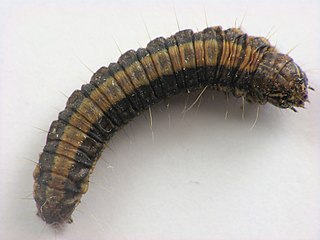Related Research Articles

Pyraustinae is a large subfamily of the lepidopteran family Crambidae, the crambid snout moths. It currently includes over 1,400 species, the majority of them tropical but some found in temperate regions including both North America and Europe.

Xylomyidae is a family of flies known commonly as the wood soldier flies. They are xylophagous and are associated with dead or dying wood.

Hypena is a genus of moths in the family Erebidae. It was first described by Franz von Paula Schrank in 1802. These non-migratory moths overwinter as pupae and almost never come to bait as adults.

Zəngişalı is a village and municipality in the Agdam Rayon of Azerbaijan. It has a population of 4,304. The municipality consists of the villages of Zəngişalı and Mahrızlı.

Mahrızlı is a village in the Agdam Rayon of Azerbaijan. The village forms part of the municipality of Zəngişalı.

Bradina is a genus of moths of the family Crambidae.

Glyphodes is a genus of moths of the family Crambidae described by Achille Guenée in 1854.

Herpetogramma is a genus of moths of the family Crambidae described by Julius Lederer in 1863. It currently comprises 106 species and is found in North America, Eurasia, Australia, New Zealand, Central and South America. Of the few species where host plants are known, the larvae mostly feed on grasses.
Lamprosema is a genus of moths of the family Crambidae described by Jacob Hübner in 1823.

Parapoynx is a genus of moths of the family Crambidae described by Jacob Hübner in 1825.

Phostria is a genus of moths of the family Crambidae.

Syllepte is a genus of moths of the family Crambidae.
Tangla is a genus of moths of the family Crambidae. The genus was erected by Charles Swinhoe in 1900.

Hypsopygia is a genus of moths belonging to the family Pyralidae. Though fairly small, they are large among their relatives. It was described by Jacob Hübner in 1825.

The Chrysauginae are a subfamily of snout moths. They are primarily Neotropical and include about 400 described species.

The Epipaschiinae are a subfamily of snout moths. Almost 600 species are known today, which are found mainly in the tropics and subtropics. Some occur in temperate regions, but the subfamily is apparently completely absent from Europe, at least as native species. A few Epipaschiinae are crop pests that may occasionally become economically significant.
Tangla sectinotalis is a moth in the family Crambidae. It was described by George Hampson in 1898. It is found in New Guinea.
Tangla polyzonalis is a moth in the family Crambidae. It was described by George Hampson in 1898. It is found on Ambon Island in Indonesia and Fergusson Island in Papua New Guinea.

Tangla Railway Station is a railway station located at Tangla in Udalguri district of Assam, India. It is about 90 km (56 mi) from the state capital Guwahati. The station has daily trains to Kamakhya, New Jalpaiguri, Dekargaon, Rangiya and Naharlagun.
References
- ↑ Nuss, M.; et al. (2003–2014). "GlobIZ search". Global Information System on Pyraloidea. Retrieved 2014-07-15.
- ↑ Savela, Markku. "Tangla zangisalis (Walker, 1859)". Lepidoptera and Some Other Life Forms. Retrieved February 1, 2018.
| This Pyraustinae-related article is a stub. You can help Wikipedia by expanding it. |